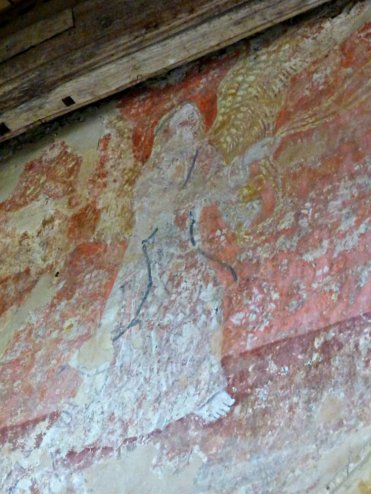
The paintings of the north transept with their beheaded saint and crowned figures would have been enough and well worth the visit. On this wall alone there are layers of decative themes, from figures to foliage, curlicues and stars. There are at least five schemes of painting, from the late 1200s to the 14th C, with the window splays being amongst the latest to be painted. No other paintings survive on this side of the church apart from one of the Cromwellian bible verses from the 17thC that were the only permitted decoration at that time in history. The rest were painted over.

On the western walls at the base of the tower, a few intriguing fragments remain. The clearest is that of a hand and part of a torso. The hand grasps a tool whose blade is at right angles to the handle, suggesting a scythe. The painting is post-reformation, so later than many of the others. It is thought that, in line with the prevailing thought of the day, this may originally have been a depiction of Father Time, and he would have been accompanied by Death. These two themes were often found together, the abstract concepts personified to remind the congregation of their mortality, in the same way as the many memento mori tombs show skeletal remains beneath the portait figures.

Tiny patches of colour show through the limewash across the walls. On the south wall, around the door, is a larger scene, too badly damaged to fully decipher. You can make out the stonework of a castle or walled city with turrets outlined against the sky. Figures look out of the windows, including a blonde wearing a beret. It is thought that this may be a fragment of a depiction of the tale of St George and the Dragon that was often painted around doorways. Opposite there would probably have been the story of St Christopher, ready to welcome pilgrims, but nothing now remains.

In the nave there are the Cromwellian verses, but as beautifully painted as theya re, you barely notice them. Instead your eyes are drawn up to the large expanse of paint above the chancel arch. There is a central space in the painting where the wooden cross … the Rood of the rood screen… would have stood. On one side a figure given as St John, on the other the Mother of Jesus. To either side are winged angels with censers, referring to the verse in Revelations 8:3 “Another angel, who had a golden censer, came and stood at the altar. He was given much incense to offer…” The golden chains frame the space where the coross would have hung.

There are two shemes on this wall. The one that runs across the top and which would have backed the rood screen dates to the 14thC. This is the brighter painting, with far more colour and a more stylised feel. Below it remain traces of an older painting, going back to the 13thC. The style is simpler… more of an outline drawing. This would once have covered the entire wall, though now only two fragmentary scenes remain.

To the north is what is thought to be the Passion, though looking at it, and seeing only limbs, I am reminded of some of the older Tarot cards depicting Judgement, where the dead rise from the earth. It is not impossible… but of course, from the floor it is impossible to get a closer look.

The style of these older paintings is not only simpler, but in some ways seem to carry a deeper emotion. They are more graphic, less comfortable… more poignant. To the south side stands the figure of the risen Christ.

His face is still clear, as are his feet, piereced and bloodied. In his hand he holds the vexillium… a processional banner or cross… and anothe figure stands close by. This is thought to be another of the common themes of medieval art… the Harrowing of Hell, when the Christ is said to have descended to limbo to free all the souls of those who had died, save only those of the damned. But to me, the most poignant painting of them all here, is that of the Feet.

Above these two fragments two figures from a later painting watch. To the south, the one we are told is St John, dressed in flowing green. I am no expert, and again, the details are difficult to capture, but I have to wonder if, for the sake of the lover of symmetry who painted the two censing angels, we should not consider the possibility that this may be another grieving woman. There was more than one Mary who grieved for Jesus, after all, and she is often shown wearing green.

It is the Mother of Jesus, though, that takes your breath. She is the most beautiful I have ever seen in a medieval wall painting of this type. She reminds me of an alabaster fragment at Stewkeley with the delicate transparency of her veil, the flowing lines of her stance. The artist who painted her knew what love looked like. From below, as you raise your eyes, the perspective softens the figure, and she is gentle, sorrowful and tender.

Not a young woman… but not old. Grieving, but not lost in grief. Serene and beautiful. The artist who painted her knew what love looked like.










































The paintings are remarkable, especially the last one of the woman, grieving. What expression!
LikeLike
The delicacy of touch too…
LikeLike
Another lovely example of how to read history. Thank you, Sue.
LikeLike
A really beautiful, simple church, Lynn.
LikeLike
The church is so lovely, and must have been simply fabulous when those scenes were fresh painted. 🙂 🙂
LikeLike
You can imagine the colours…
LikeLike
🥰💕
LikeLiked by 1 person